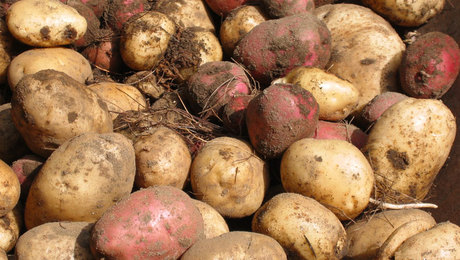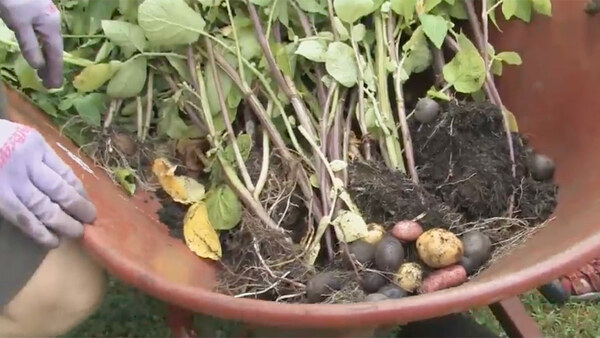Welcome to Homegrown/Homemade, a video series from FineGardening.com and our sister site FineCooking.com. We’ll be following a gardener (Danielle Sherry) and a cook (Sarah Breckenridge) as they plant, maintain, harvest, store, and prepare garden vegetables. Watch them plant potatoes.
Episode 4: How to Store and Prep Potatoes
If you don’t plan on using your potatoes right away, store them in a cool, dark place (about 50°F). Don’t put them in the fridge, ever. The fridge is too cold, and if you put them there the starch will convert to sugar, which is not a good thing with potatoes. Potatoes in contact with light will turn green, a sign of the presence of solanine, which is toxic. If you see green on your potatoes, peel off the ¼ inch to remove it. Ditto for sprouts; remove them and the area around them before cooking.
If you’re prepping a batch of potatoes for potato salad or other potato dish, you may have noticed that they start darken fairly quickly. Here’s a tip for keeping peeled potatoes white. It’s oxidation that causes them to turn brownish-pink after peeling, but if you submerge them in cold water, they’ll look a lot more appetizing.
Episode 1: How to Plant Potatoes
From a cook’s point of view, potatoes are not all the same. There are waxy and starchy types, and Sarah is planting three waxy fingerling types and Yukon Gold potatoes, using purchased “seed” potatoes. Before planting, Sarah and Danielle cut the potatoes into chunks, with at least two “eyes” (buds) per piece. Then they dig a planting trench 6 inches deep, fill the trench with 3 inches of compost, and place the seed potatoes in the trench cut side down, 6 to 8 inches apart. Finally, they shovel 3 more inches of compost on top.
Episode 2: How to Hill Potatoes
The main reason to hill potatoes is to increase yield. Potatoes form along the underground stem of the plant, and when you hill them, effectively lengthen the underground portion of the stem. You can either add additional soil to the bed and then mold it around the plants, or you can scoop up soil from the rows and press it against the stems. Later in the season, it’s easy to reach in and check the potatoes for size before you harvest them.
Episode 3: How to Harvest Potatoes
You don’t have to wait until the end of the gardening season to harvest potatoes. In the middle of the summer, if your potato plants are large and the plants are flowering, you may be able to harvest “new” potatoes. New potatoes are thin skinned and sweet. You can check the hills and feel around for potatoes, then either harvest them up individually or uproot the entire plant. You can use new potatoes right away, or store them.
Recipe: Red, White, and Blue Potatoes
Cut the potatoes in half and toss with olive oil, rosemary, crushed fennel seed, red pepper, salt, and pepper, then place cut side down on a baking sheet and roast for about an hour at 375°F. Add whole peeled garlic cloves after 20 minutes of roasting, stir, and continue baking. Stir every quarter-hour. Test for doneness with a paring knife.


















Comments
Log in or create an account to post a comment.
Sign up Log in